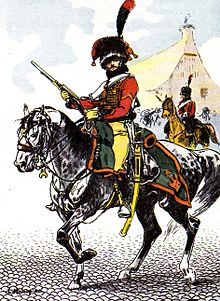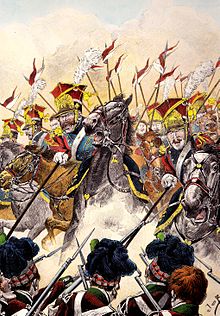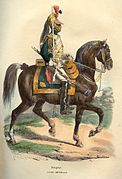Cavalerie de la Garde impériale
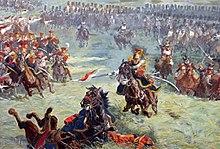
The Cavalerie de la Garde impériale (Cavalry of the Imperial Guard) were the cavalry formations in the Garde Impériale of Napoleon I. As elite combat troops , they formed the reserve of the emperor with which he carried out the decisive blow in battle or cleared up precarious situations.
When it was established in 1804, the guard cavalry consisted of the three units taken over from the Guard des consuls :
- the " Chasseurs à cheval de la Garde impériale " (hunters on horseback of the Imperial Guard)
- the Grenadiers à cheval de la Garde impériale (Grenadiers on horseback of the Imperial Guard)
- and the Mamelouks de la Garde impériale ( Mameluks of the Imperial Guard)
After that, other cavalry regiments were hired into the Imperial Guard:
- the Dragons de la Garde impériale in 1806 ( Dragoons of the Imperial Guard)
- the Lanciers polonais de la Garde impériale 1807 (Polish Uhlans of the Imperial Guard)
- the Lanciers rouges de la Garde impériale 1810 (Red Uhlans of the Imperial Guard)
- the " Lanciers lituaniens de la Garde impériale " 1812 (Lithuanian Uhlans of the Imperial Guard)
- the Éclaireurs de la Garde impériale 1813 (enlighteners of the Imperial Guard)
- the Tartares lituaniens de la Garde impériale 1812 (Lithuanian Tartars of the Imperial Guard)
Other associations were provided to the guard, such as:
- Gendarmerie d'élite de la Garde impériale (elite gendarmerie of the Imperial Guard)
- Gendarmerie d'ordonnance de la Garde impériale (Ordonnanz-Gendarmerie of the Imperial Guard)
- Chevau-légers du Grand-duché de Berg ( Chevaulegers of the Grand Duchy of Berg )
- Gardes d'honneur de la Garde impériale (French Honor Guard)
At the height of the First Empire in 1812, the guard cavalry consisted of a total of 7,000 riders, out of a total of 77,000 riders of the Grande Armée .
Lineup
The guard was established by imperial decree of July 29, 1804 and replaced the consular guard that had existed until then. Of the three first existing units, the company of the "Mamelouks de la Garde impériale" was affiliated to the regiment of the "Chasseurs à cheval de la Garde impériale".
The "Gendarmerie d'élite de la Garde impériale" also belonged to the Guard Cavalry, but had completely different tasks than the other units.
The regiment of the "Lanciers polonais de la Garde impériale" was formed in 1807 from Polish nobles. However , they did not receive a lance until 1809, after the battle of Wagram . A second Uhlan regiment was formed in 1810 when the regiment of the “Lanciers rouges de la Garde impériale” was formed from parts of the “Hussards de la Garde hollandaise” (Dutch Guard Hussars). The last to be set up in 1812 was the regiment of the "Lanciers lituaniens de la Garde impériale". This regiment had an escadron "Tartares lituaniens de la Garde impériale" (Lithuanian Tartars) attached.
In 1813 three regiments "Éclaireurs de la Garde impériale" (named after a reconnaissance force) were established and equipped with lances. The first of these regiments was assigned to the grenadiers on horseback, the second to the dragoons and the third to the Polish Uhlans.
The hunters on horseback, the grenadiers on horseback, the dragoons, the Mameluks, the Polish Uhlans and the 1st Escadron of the 1st Éclaireurs Regiment belonged to the so-called Old Guard.
Chasseurs à cheval
The Capitaine Bessières des 22 e régiment de chasseurs à cheval became the commandant of the new corps. He had the right to choose the members of the company himself.
The “Compagnie des guides” distinguished itself in the battle of the Bridge of Arcole and then again in the campaign to Egypt, where it took part in the attack on Mont Thabor and in 1799 the siege of Saint-Jean-d'Acre. After Napoleon's return to France and the establishment of the consulate , the “Compagnie des guides” became the “Compagnie des chasseurs à cheval de la Garde des consuls” (company of hunters on horseback in the consular guard). Captain Eugène de Beauharnais became the commanding officer
In 1804 Napoleon became emperor and set up an imperial guard. The previous company of hunters on horseback was increased to a regiment and received its new name "Regiment des chasseurs à cheval de la Garde impériale". It consisted of four escadrons and was 1018 strong. In addition, the Mamluk company was subordinate to him.
The unit was involved in the campaign against Austria under the command of Colonel Morland, for example in the battle of Ulm and above all in the battle of Austerlitz , where the regiment, together with the mounted guards and the Mameluks, repulsed the Russian guard cavalry. They had 22 casualties - including their commander, Colonel Morland.
The regiment was not involved in the campaigns in Prussia and Poland in 1806, but the following year it attacked the Russian infantry at the Battle of Eylau . It was under the command of Général Dahlmann , who was fatally wounded in this operation.
In 1808, Général Lefebvre-Desnouettes took command of the regiment. In the same year it was sent to the Spanish War of Independence , where it helped suppress the Dos de Mayo uprising. After winning the Battle of Benavente, they returned to France to be used in the Battle of Wagram .
During the Russian campaign , the "Chasseurs à cheval de la Garde" took over the protection of Napoleon in the battle near Horodnja and drove back attacks by the Cossacks with the help of the other regiments of the guard cavalry. At the end of the campaign the regiment consisted of only 209 riders. However, it was soon replenished and fought on German soil and in France
- Battle of the Nations near Leipzig ,
- the battle of Hanau ,
- the battle of Montmirail
- and the battle of Craonne .
After Napoleon's first abdication and the return of King Louis XVIII. the regiment was renamed "Corps royal des chasseurs de France" until it was given its old name by Napoleon after his return from Elba. It fought for the last time at the Battle of Waterloo and was disbanded between October 26 and November 6, 1815 after Napoleon's final abdication.
Grenadiers à cheval
The Grenadiers à cheval go back to October 1796 when the French government decided to add a cavalry unit to the "Garde du Directoire" (Guard of the Directory ). A corps of two companies, altogether 112 horsemen, was set up. In the following year (after the coup d'état of 18 brumaire ) it became the first cavalry unit of the "Guard Consulaire"
After the establishment of the empire by Napoleon, the "Corps des grenadiers à cheval de la Garde des consuls" (Grenadiers on horseback of the consular guard) became the "Regiment des grenadiers à cheval de la Garde impériale". It consisted of four escadrons with a total of 1018 riders and officers. The regiment took part in the campaign in Austria and fought in the battle of Austerlitz , where it was able to repel the Russian guard cavalry under Grand Duke Constantine with the guard hunters on horseback and the Mameluks . The regiment did not take part in the campaign against Prussia and Poland, but was again involved in the battle of Eylau. Here he managed, under the leadership of Colonel Lepic, to escape an encirclement and to break through to the French lines.
The regiment was used in Spain and was during the uprising at the Dos de Mayo in Madrid in garrison . In 1809 the grenadiers fought in the Battle of Essling and moved to Russia with five escadrons. There were heavy losses here and in February 1813 there were only four escadrons left. This was followed by the campaigns in Germany and France, where the unit fought in the Battle of Vauchamps , the Battle of Craonne and the Battle of Paris .
After the first return of King Louis XVIII. the unit was renamed “Corps royal des cuirassiers de France”, but was given the old name again during Napoleon's rule for a hundred days. In the battle of Waterloo it rode an attack on the British infantry carts. After the final abolition of the German Empire, the regiment was disbanded on November 25, 1815.
Mamelouks
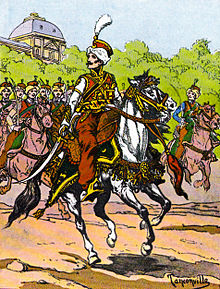
During the campaign in Egypt in 1798, the Général Napoléon Bonaparte faced the Mameluks who had been in the service of the Ottoman Empire for several centuries . Impressed by their soldiery qualities, he decided to incorporate such a unit into the French army. This Mamluk corps was part of the expeditionary army until they returned to France on October 13, 1801. A decree then ordered a 240 cavalry Mamluk escadron to be placed in the consular guard. The workforce was then reduced to 150 riders on January 7, 1802. Colonel Jean Rapp , aide de camp of Napoléon , became the commanding officer . On April 2, 1802, the Escadron consisted of 13 officers and 155 men. In 1804 the company was subordinated to the regiment of guardsmen on horseback.
In the campaign against Austria they earned attention in the battle of Austerlitz, where French infantry were hard-pressed by Russian guard cavalry at the height of Pratzen. The emperor therefore ordered the Maréchal Bessières to intervene with his own guard cavalry, which was kept in reserve. A first attack by the mounted hunters and grenadiers failed, but the Mameluks made a breakthrough, stumbled into a Russian carée and overran an artillery battery. After this did Napoleon approved of the Mameluk company an eagle. The Mameluks then went on campaigns to Prussia and Poland, where they took part in the Battle of Pultusk and the Battle of Eylau.
During the participation in the Spanish War of Independence, the Mameluks were involved in the suppression of the uprising at Dos de Mayo. Here they drew the hatred of the Spaniards because this was what the descendants of the Moors saw in them. In 1812 the Escadron took part in the Russian campaign, where it was constantly to be found at the side of the Chasseurs à cheval and suffered similar heavy losses. In 1813 the Escadron was set up again, which then fought in the battle of Dresden and Hanau. After the French withdrew from Germany, they were still involved in the battles at Montmirail, Saint-Dizier and Paris.
During the first restoration, the Mameluks were incorporated into the “Corps royal des chasseurs de France”, but were given back their old status after Napoleon's return. After this had finally disappeared, the remaining Mamelukes moved to the depot of the homeless (Dépôt des réfugiés) in Marseille , where most were killed by the royalist population.
Dragons
The regiment was set up in April 1806. The reason was the excellent attitude of the line dragons in the campaign against Austria in 1805. Napoléon issued a decree to set up a dragoon regiment that should belong to the imperial guard. The unit consisted of four escadrons of two companies each. The emperor himself determined who was assigned to the regiment's officer corps. Colonel Arrighi de Casanova became the first in command .
After Napoleon's wife Josephine de Beauharnais to the regiment owner had made, the Dragoon Guards led from then on, the term "Dragons de l'Impératrice" (Dragoons of the Empress).
A few months later, the regiment took part in the Battle of Friedland, where it formed the left wing of the Guard Cavalry. During the Russian campaign in 1812 - especially after the Battle of Malojaroslavets and the Battle of the Beresina , the regiment covered the retreat of the French troops and was almost completely wiped out in the process. In 1813 the Dragoons fought in the Battle of Leipzig and in the Battle of Hanau . In the battle near Saint-Dizier , the dragoons, together with a peloton of Mameluks , threw the opposing infantry out of their positions, the latter having to leave 18 cannons behind.
During the first restoration , the regiment was renamed "Corps royal des Dragons de France". After the return of Napoleon ( rule of the hundred days ) it got its old name back. In the Battle of Waterloo, the regiment under the command of Maréchal Ney attacked British infantry carts on Mont-Saint-Jean. It suffered heavy losses from the precise rifle fire of the British fusiliers. At the end of the campaign in Belgium, the regiment had 25 fallen officers and more than 300 fallen horsemen to mourn.
After Napoleon's final abdication, the Guard Dragons were sacked.
Lancers polonais

After the suppression of Prussia in 1807, Napoleon was escorted by a noble Polish honor guard as he entered Warsaw . Enthusiastic about this, he decided by decree of April 6, 1807 to set up a "Régiment de chevau-légers polonais" (regiment of Polish light cavalry) that should belong to the imperial guard. It was under the command of Colonel Wincenty Krasiński. Experienced officers of the guard cavalry were added to the 968 riders who were not militarily trained. Little by little, they were brought together in the Chantilly Castle depot before they set out for Spain to fight the riots on the Dos de Mayo. Then it went to the battle of Medina de Rioseco and under the command of Général Lasalle in the battle of Burgos. While Napoleon was marching on Madrid, the Napoleonic formations with the Chevau-légers were stopped at the Col de Somosierra by the troops of General Benito de San Juan. After the infantry was unable to overwhelm the Spaniards, the Emperor ordered an attack by the 3rd Escadron of the Chevau-légers polonais. Commanded by Jan Leon Kozietulski, the Poles suffered heavy losses in enemy defensive fire, but were able to prevail and capture the Spanish artillery. This action brought the regiment the admiration of Napoleon, who raised it in rank and placed it in the "old guard".
Back to France, the regiment went on a campaign to Austria, where it was able to overrun the Austrian Uhlans of Karl Philipp zu Schwarzenberg in the Battle of Wagram . After this action, Napoleon complied with Colonel Krasiński's request and renamed the regiment "Lanciers polonais" (Polish Uhlans). It took in 1810 after the list "Lanciers rouges de la Garde impériale" the rank before this one. In the Russian campaign, the regiment fought in the battle near Horodnia and in the battle of Krasnoye . After heavy losses, the regiment was re-established and fought in the battle of Lützen , in the battle of Peterswalde, in the battle of Hanau and in the battle of Großgörschen , where it lost Major Dominique Hieronime Radziwill. In the campaign in France in 1814 it fought in the Battle of Brienne , the Battle of La Rothière, the Battle of Montmirail , the Battle of Berry-au-Bac, the Battle of Craonne , the Battle of Reims and the Battle of Paris .
In the first restoration, the regiment was disbanded and the men sent back to Poland. except for an escadron under the command of Paweł Jerzmanowski, which accompanied Napoleon to Elba. During the reign of the hundred days, this escadron was employed as 1st escadron in the regiment of the red Uhlans, where it fought in the battle of Waterloo. After the second return of King Louis XVIII. the Escadron was finally released, his relatives taken over into the Russian cavalry.
Lanciers rouges
In 1810 Napoleon annexed the Kingdom of Holland and de facto deposed his brother Louis Bonaparte . On July 14th, the former kingdom was officially incorporated into France by decree. At the same time, the "Garde royale hollandaise" (Royal Dutch Guard) was incorporated into the Imperial Guard. On August 10, the "Régiment de hussards de la Garde royale" (regiment of the hussars of the royal guard) under the command of Colonel Dubois set out for Versailles , where it arrived on August 30. The four Dutch escadrons fraternized with their French comrades and by decree of September 13, 1810, they were converted into a second regiment of Guardians. Général Colbert-Chabanais became the commander . The NCOs of the corps, instructed by the Polish Uhlans from Chantilly, taught their men how to use the lance.
In 1812 the regiment went into the Russian campaign, where it initially belonged to the vanguard and performed extensive security services for the foraging columns . Then it was combined with the Polish Uhlans into a brigade, which was under the command of Général Colbert-Chabanais. When it arrived in Moscow in October, the regiment had a combat strength of 556 men. After the fire in Moscow and the battle of Tarutino , the Uhlans formed part of the rearguard that had to cover the French retreat. On October 24th, they rejected a massive attack by the Cossacks on the rearguard, outnumbered. The bad climatic conditions caused great sacrifices among the Uhlans and their horses, at the end of the campaign only 60 riders had a uniform. Rebuilt, they fought in the Battle of Reichenbach on May 23, 1813. In 1814 the Uhlans were involved in fighting as the French retreated to Paris in Belgium
During the first restoration, the red Uhlans were renamed the “Corps royal des chevau-légers lanciers de France”. During the reign of the Hundred Days they got their old name back and incorporated the Escadron of the Polish Uhlans from Elba. The regiment belonged to the "Brigade de cavalerie légère" (Light Cavalry Brigade) of the Imperial Guard and moved with them to Belgium, where it fought in the Battle of Quatre-Bras and attacked British infantry carées in the Battle of Waterloo. After Napoleon's second abdication, it was dissolved on August 30, 1815.
Lancers of lituania
At the beginning of July 1812, Napoleon decided to set up a third Uhlan regiment for his guard. It was planned that the regiment should consist of five escadrons with a total of 1218 men. Two escadrons from Lithuanian nobles were immediately set up in Warsaw. The regimental commander was Général Jan Konopka, until then a major in the "Regiment des lanciers polonais de la Garde impériale". As a reconnaissance component, he was assigned an escadron of the "Tartares lituaniens de la Garde impériale" (Lithuanian Tartars of the Imperial Guard).
During the Russian campaign, the Uhlans received the order to return to Minsk . On the way, General Konopka decided to stop in the village of Slonim and move into quarters here. His deputy, Major Colonel Tanski, had advised him to continue the march back immediately. It was in vain, only he himself was sent on to the Grodno depot with two escadrons. The night after his departure, the Russian General Czaplicz and a detachment attacked the camp of the Uhlans. Général Konopka and 246 of his men were taken prisoner. The regiment also lost the office with all important papers.
After this defeat, the regiment consisted only of the two escadrons of Colonel-Major Tanski in Grodno. On March 22, 1813, the unit was dissolved and the remnants incorporated into the "Régiment des lanciers polonais de la Garde impériale".
Tartares lituania
In June 1812, the General Michel Sokolnicki proposed to set up a unit of Lithuanian Tatars. They were to be recruited from people whose ancestors or families came from Crimea and who had settled in the Baltic States . The Tatars there are excellent riders, their righteousness was praised by him, and they are also known for their bravery. Napoleon then ordered the establishment of such a unit, it should be about 1000 horsemen strong and was officially put into service in October 1812. However, no more than a single Escadron could be set up.
Under the command of Major Achmatowicz, they took part in the Russian campaign together with the Lithuanian Uhlans. They suffered heavy losses in the Battle of Vilna, including their commander. After the campaign, the survivors were initially housed with the red Uhlans and later as the 15th company with the Polish Uhlans. Although of little use, they fought in the battles in Germany and then in the retreat through France. Most recently they were subordinate to the "3e régiment des éclaireurs de la Garde impériale" (3rd regiment of the reconnaissance of the imperial guard).
After Napoleon's abdication on April 6, 1814, the last of the Tatars returned to their homeland.
Éclaireurs
After the gloomy prospects of 1813 and the first possible relocation of the fighting to French soil since the Revolutionary Wars, Napoleon reorganized his guard on December 4, 1813. Three new guards regiments were set up. The first, the "Éclaireurs-grenadiers" became the "Grenadiers à cheval de la Garde impériale", the second, the "Éclaireurs-dragons" became the "Dragons de la Garde impériale" and the third, the "Éclaireurs-lanciers" became the "Lanciers polonais de la Garde impériale" subordinated.
- 1 he regiment des éclaireurs de la Garde impériale
- 2 e régiment des éclaireurs de la Garde impériale
- 3 e régiment des éclaireurs de la Garde impériale
Units assigned to the Guard or temporarily standing by your side
Gendarmes d'élite
The "Gendarmerie d'élite" was set up as a single escadron in July 1801 and in 1802 assigned to the consular guard. From 1804 she was integrated into the imperial guard and at that time consisted of 2 escadrons of two companies each. In addition, two companies came on foot for a short time. The minimum height for the gendarmes was set at 1.76 meters. Including the gendarmes on foot, the corps consisted of 632 officers, NCOs and men. It was counted among the prestigious "Old Guard". After the foot companies were dissolved in 1806, the workforce fell to 456 riders.
The elite gendarmes were responsible for the security of the imperial palace, the other military accommodations and the field quarters of the emperor. Less often they were responsible for protecting the emperor on his travels or protecting important personalities.
Although they played a minor role in the fighting, they took part in the Battle of Medina de Rioseco and the Battle of Montmirail. They were also involved in the campaign to Belgium in 1815 . The "Gendarmes d'élite" were dissolved in September 1815.
Gendarmes d'ordonnance
By decree of October 1, 1806, Napoleon ordered the establishment of a "Régiment de gendarmes d'ordonnance", which should be assigned to the imperial guard. The emperor wanted to form them from members of the aristocracy of the ancien régime who had been banished from France during the revolution. It consisted of two escadrons of two companies each; each 80 riders strong. However, this number was not reached, there were never more than 300 gendarmes. In theory, anyone wishing to join the unit had to pay 1900 francs for their uniform and equipment. He also had to prove that he could pay his family a pension of 600 francs. On August 1, 1807, the orderly gendarmerie consisted of 216 horsemen.
The corps only existed for a short time, took part in the battle of Guttstadt and fought against Cossacks. Two gendarmes were killed and five others wounded. On February 11th, the gendarmes entered Stettin with Napoleon . They also took part in other smaller skirmishes, for example in March near Kolberg (see also: Siege of Kolberg, 1807 ). After the Battle of Friedland , the Corps was disbanded on November 23, 1807.
Chevau-Legers de Berg
On December 17, 1809, Napoleon completely incorporated the former bodyguard cavalry of the Grand Duke of Cleve-Berg , and later King of Naples , Joachim Murat, built in 1807 into the imperial guard.
Initially, the Escadron "Gardes du corps" was assigned to the Guard on November 17, 1808. She moved into Madrid with Joseph Bonaparte . The 2nd Escadron went to Naples with Murat, the two remaining Escadrons stayed in Munster and on August 29, 1808 they merged into the newly formed "Régiment des chasseurs à cheval de Berg". The "Corps des chevau-légers" was dissolved on January 11, 1809. the riders distributed among the chasseurs à cheval and the other cavalry units of the guard.
The "Régiment des chasseurs à cheval de Berg" was renamed the "Régiment des lanciers de Berg" at the end of 1809 and was assigned to the Imperial Guard on December 17th.
The regiment fought in Spain against the guerrillas and against the British army. In 1812 the Lanciers de Berg formed a brigade with the 15e régiment de chasseurs à cheval and fought on October 23 in the battle near Villodrigo. In 1813 it was dissolved.
In March 1812 a second regiment was set up, but it was almost completely wiped out in the battle of the Beresina .
Gardes d'honneur
The "Gardes d'honneur" (honor guard) was set up by Napoleon after the costly Russian campaign to strengthen the decimated guard cavalry. The 10,000 men hurriedly formed four regiments, which were uniformed like hussars. The sons of the most important families of the bourgeoisie and the lower nobility from the 130 departments of the empire were called. They had to pay for their own equipment. The regiments were assigned to the Guard on July 29, 1813, the 1st Regiment to the Chasseurs á cheval, the 2nd Regiment to the Dragoons, the 3rd Regiment to the Grenadiers á cheval and the 4th Regiment to the Lancers.
They first came into battle in Saxony in 1813 and were still in the retreat battles in France the following year, particularly the Battle of Chateau-Thierry and the Battle of Montmirail. involved. After Napoleon's first abdication, the Gardes d'honneur was dissolved in 1814.
Commander of the Guard Cavalry
From 1804 to 1813, the Maréchal Jean-Baptiste Bessières , Duke of Istria, was in command of the Imperial Guard Cavalry. Formerly a captain in the “22 e régiment de chasseurs à cheval”, in 1796 he became the commander of the “Compagnie des guides à cheval” with which he participated in the campaign in Italy and the expedition to Egypt. He attacked with the cavalry of the consular guard in the battle of Marengo and was promoted to Général de brigade in July 1800 . After the establishment of the First Empire in 1804 he was given the dignity of Maréchal d'Empire and he was appointed " Colonel général de la cavalerie de la Garde impériale".
Bessières drove reforms and ensured strict discipline. He was the commander in chief of the guard cavalry on parades but also on the campaigns. During the fighting, Bessières acted with all his might, but nevertheless prudently and not carelessly. Often he led the cavalry attacks personally, which made him popular with his men. He was wounded by a bullet in the Battle of Wagram. Napoleon then wrote to him:
"Bessières, voilà un beau boulet, il a fait pleurer ma Garde."
(Bessières, that was a nice bullet that shook my guard.)
He kept his command during the Russian campaign and the fighting in Germany. At Weißenfels he was hit by an Austrian bullet on May 1, 1813, which shattered his hand and then pierced his chest.
His death caused great consternation among Napoleon and the Guard.
gallery
- Members of Adolphe de Chesnel's guard cavalry
- Members of the guard cavalry. Drawings by Hippolyte Bellangé
Footnotes
- ↑ the Old Guard (Vieille garde) was the most highly regarded of the three guard formations
- ↑ this number has probably not been reached
- ^ Note de l'éditeur
- ↑ ( planche uniformologique de la page 59 )
literature
- Philip Haythornthwaite & Richard Hook "La Garde impériale" DelPrado & Osprey Publishing 2004, ISBN 2-84349-178-9
- François-Guy Hourtoulle, Jack Girbal & Patrice Courcelle “Soldats et uniformes du Premier Empire” Histoire et Collections 2004, ISBN 978-2-913903-54-8
- G. Charmy "Splendeurs des uniformes de Napoléon - La Garde impériale à cheval" Charles Hérissey 2003 ISBN 978-2-914417-10-5
- Juan María Martínez "Les mamelouks de Napoléon - Cavaliers des Guerres napoléoniennes" Del Prado & Osprey Publishing 2003, ISBN 2-84349-154-1
- Alain Pigeard "La Garde impériale 1804-1815" Tallandier 2005, ISBN 978-2-84734-177-5
- Alain Pigeard & Vincent Bourgeot "La Cavalerie de la Garde Impériale" Soteca 2013, ISBN 979-1-09-156158-7
- Henry Lachouque "La Garde impériale" (Les grands moments de notre histoire) Lavauzelle 1982 ISBN 2-7025-0001-3
- Gilles Dutertre "Les Français dans l'histoire de la Lituanie" EditeurL'Harmattan 2009 ISBN 978-2-296-07852-9
- Jean Tranié & Juan-Carlos Carmigniani "Les Polonais de Napoléon (L'épopée du 1er régiment de lanciers de la garde impériale)" Editeur opernic 1982
- Emir Bukhari & Angus McBride "Napoleon's Guard Cavalry" Editeur Osprey Publishing Osprey | série Men-at-Arms 1978 ISBN 0-85045-288-0
- Ronald Pawly & Patrice Courcelle Napoleon's Mounted Chasseurs of the Imperial Guard | Éditeur Osprey Publishing 2008 ISBN 978-1-84603-257-8
